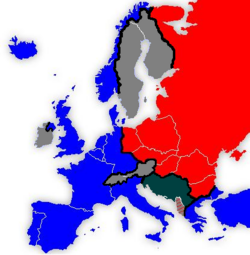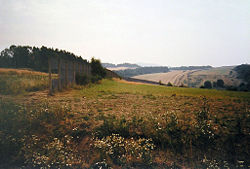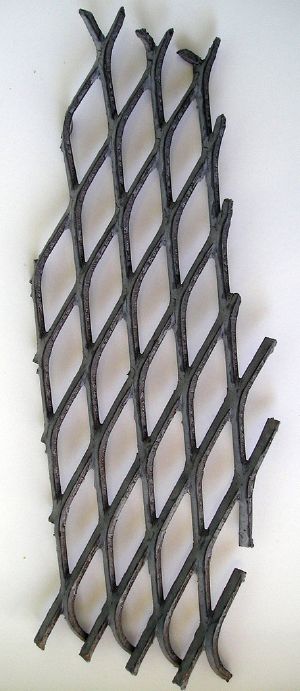Iron curtain

The Iron Curtain is a Western term made famous by Winston Churchill referring to the boundary which symbolically, ideologically, and physically divided Europe into two separate areas from the end of World War II, until the end of the Cold War, roughly 1945 to 1990. After the end of the Cold War and the spheres of influence were determined by the Allied powers at Potsdam and Yalta, the divisions between the wartime allies soon reappeared as the struggle between capitalism and communism heated up. These tensions were felt as, one by one, communist governments were installed in the Eastern European states under the Soviet sphere of influence. The "iron curtain" became the symbol of the division between two competing ideologies and systems as the competition for world dominance of these two systems dominated the last half of the twentieth century. The fall of the Berlin Wall signaled the end of the iron curtain, as communism collapsed and freedom and democracy came to the Eastern bloc. The West finally prevailed, demonstrating that ideals cannot be artificially kept behind walls and boundaries.
Origins of the Iron Curtain
The first recorded use of the term "iron curtain" was in 1819, in the general sense of "an impenetrable barrier." By 1920, it had become associated with the boundary of the Soviet Union's sphere of influence.
It was used during World War II by German Propaganda Minister Joseph Goebbels and later Count Lutz Schwerin von Krosigk in the last days of the war; however, its use was popularized by the former British Prime Minister Winston Churchill, who used it in his "Sinews of Peace" address March 5, 1946, at Westminster College, Missouri, in Fulton, Missouri:
From Stettin (Szczecin) in the Baltic [Sea] to Trieste in the Adriatic [Sea] an "iron curtain" has descended across the Continent. Behind that line lie all the capitals of the ancient states of Central and Eastern Europe. Warsaw, Berlin, Prague, Vienna, Budapest, Belgrade, Bucharest and Sofia; all these famous cities and the populations around them lie in what I must call the Soviet sphere, and all are subject, in one form or another, not only to Soviet influence but to a very high and in some cases increasing measure of control from Moscow.
After its fall, a section of the Berlin Wall was transported to and erected at Westminster College.
Political, economic, and military realities
East of the Iron Curtain
While the Iron Curtain was in place, the countries of Eastern Europe and many in Central Europe (except West Germany, Liechtenstein, Switzerland, and Austria) were under the political influence of the Soviet Union. Indeed the Central European states to the east of the Curtain were frequently regarded as being part of Eastern Europe, rather than Central Europe even though geographically Prague, the capital of the Czech Republic, is considerably further West than Vienna, the capital of Austria. Berlin, the capital of the reunited Germany, is only slightly to the West of Prague.
Many of the states were members of the Soviet Union itself (the Soviet Socialist Republics), while, with two exceptions, the neighboring countries of the Eastern bloc were ruled by pro-Soviet governments, kept in place by the threat of military force. The two exceptions were Socialist Federal Republic of Yugoslavia, which retained its full independence, and Albania, which escaped Soviet influence in the 1960s, and aligned itself with China; both Albania and Yugoslavia were Communist states.
To the east of the Iron Curtain, the states developed their own international economic and military alliances, COMECON (Council for Mutual Economic Assistanc) and the Warsaw Pact.
West of the Iron Curtain
To the west of the Iron Curtain, the countries of Western and Southern Europe, along with Austria, West Germany, Liechtenstein, and Switzerland, operated market economies. With the exception of a period of fascism in Spain and Portugal and military dictatorship in Greece, these countries were ruled by democratic governments.
Most states to the west of the Iron Curtainâwith the exception of neutral Switzerland, Liechtenstein, Austria, Sweden, Finland, and Republic of Irelandâwere allied with the United States within NATO. Economically, the European Community and the European Free Trade Association were the Western counterparts to COMECON.
The Iron Curtain as a physical entity
The Iron Curtain took physical form in the shape of border defenses between the countries of the western and eastern blocs. These were some of the most heavily militarized areas in the world, particularly the so-called "inner German border"âcommonly known simply as (die Grenze in German)âbetween East and West Germany. The inner German border was marked in rural areas by double fences made of steel mesh (expanded metal) with sharp edges, while near urban areas a high concrete barrier similar to the Berlin Wall was built. The barrier was always a short distance inside East German territory to avoid any intrusion into Western territory. The actual borderline was marked by posts and signs and was overlooked by numerous watchtowers set behind the barrier. In some places, a "death strip" was constructed on the East German side of the barrier, in which unauthorized access would be met with bullets. The strip of land on the West German side of the barrierâbetween the actual borderline and the barrierâwas readily accessible but only at considerable personal risk, as it was patrolled by both East and West German border guards. Shooting incidents were not uncommon, and a total of 28 East German border guards were killed between 1948â1981 (some may have been victims of "friendly fire" by their own side).
Elsewhere, the border defenses between west and east were much lighter. The border between Hungary and neutral Austria, for instance, was marked by a simple chain link fence which was easily removed when it became the first part of the Iron Curtain to be dismantled in 1989.
In parts of Czechoslovakia, the border strip became hundreds of meters wide, and an area of increasing restrictions was defined as one approached the border. Only people with the appropriate government permission were allowed to get close to the border.
The creation of these highly militarized no-man's lands led to defacto nature reserves, creating a wildlife corridor across Europe that helped the spread of several species to new territories.
The term "Iron Curtain" was used to describe the isolation of Eastern countries from Western Europe. It also applied only to the fortified borders in central Europe; it was never used for similar borders in Asia between communist and capitalist states. The border between North Korea and South Korea is very comparable to the former inner German border, particularly in its degree of militarization, but it has never conventionally been considered part of the Iron Curtain.
Reactions to Churchill's speech
At first, many countries in the West widely condemned the speech. In the context of the recent defeat of Nazi Germany and Japan by the Allied Powers, which included the Soviet Union, much of the Western public still regarded the Soviets as close allies. Many saw Churchill's speech as warmongering and unnecessary. In light of Soviet archives now public, many historians have now revised their opinion.
Although the phrase was not well received at the time, as the Cold War progressed, it gained popularity as a short-hand reference to the division of Europe. The Iron Curtain served to keep people in and information out of the Eastern countries, and the metaphor eventually enjoyed wide acceptance in the West.
In the Soviet Union, the speech was seen by Joseph Stalin as reinforcing his view that a future conflict with the West was inevitable. Over the following months, through a mixture of persuasion and purges of those holding contrary views, the Soviet Union did indeed come to see the West as a threat, rather than the ally they had been during World War II. The Cold War had begun in earnest.
Antagonism between East and West
The antagonism between the Soviet Union and the West that led to Churchill's speech had various origins.
The United Kingdom, France, Japan, Canada, the United States and many other countries had backed the White Russians against the Bolsheviks during the 1918â1920 Russian Civil War, and the fact hadn't been forgotten by the Soviets. In the build up to World War II and in the face of the Western appeasement of Hitler, the Soviets signed the Molotov-Ribbentrop Pact with Nazi Germany, one of the intentions of which was to divide the border states between them to form a buffer zone. Following the war Stalin was determined to acquire a similar buffer against Germany with pro-Soviet states on its border, leading to strained relations at the Yalta Conference (February 1945) and the subsequent Potsdam Conference (August 1945).
In the West, there was not only opposition to Soviet domination over the buffer states, but the fear grew that the Soviets were building an empire that might be a threat to them and their interests. And, in particular, Churchill was concerned that the United States might return to its pre-war isolationism, leaving the exhausted European states unable to resist Soviet demands. President Franklin D. Roosevelt had announced at Yalta that after the defeat of Germany, U.S. forces would be withdrawn from Europe within two years (Antony Beevor, Berlin: The Downfall).
Earlier usages of the term
There are various earlier usages of the term "Iron Curtain" pre-dating Churchill. Some suggest the term may have first been coined by Queen Elisabeth of the Belgians after World War I to describe the political situation between Belgium and Germany, in 1914. An iron curtain, or eisener Vorhang, was an obligatory precaution in all German theaters to prevent the possibility of fire from spreading from the stage to the rest of the theater. Such fires were rather common as the decor often was very flammable. In case of fire a metal wall would separate the stage from the theater, secluding the flames to be extinguished by firefighters. Douglas Reed used this metaphor in his book Disgrace Abounding: "The bitter strife [in Yugoslavia between Serb unionists and Croat federalists] had only been hidden by the iron safety-curtain of the King's dictatorship."
On February 25, 1945, Joseph Goebbels wrote of an "iron curtain" in his weekly newspaper Das Reich:
If the German people lay down their weapons, the Soviets, according to the agreement between Roosevelt, Churchill, and Stalin, would occupy all of East and Southeast Europe along with the greater part of the Reich. An iron curtain [ein eiserner Vorhang] would fall over this enormous territory controlled by the Soviet Union, behind which nations would be slaughtered. The Jewish press in London and New York would probably still be applauding.
The first oral mention of an Iron Curtain was in a broadcast by Count Lutz Schwerin von Krosigk to the German people on May 2, 1945:
In the East the iron curtain behind which, unseen by the eyes of the world, the work of destruction goes on, is moving steadily forward.
The first recorded occasion on which Churchill used the term "iron curtain" was in a May 12, 1945, telegram he sent to U.S. President Harry S. Truman:
I am profoundly concerned about the European situation. ⌠3. An iron curtain is drawn down upon their front. We do not know what is going on behind. There seems little doubt that the whole of the regions east of LĂźbeck-Trieste-Corfu will soon be completely in their hands. To this must be added the further enormous area conquered by the American armies between Eisenach and the Elbe, which will, I suppose, in a few weeks be occupied, when the Americans retreat, by the Russian power. All kinds of arrangements will have to be made by General Eisenhower to prevent another immense flight of the German population westward as this enormous Muscovite advance towards the centre of Europe takes place. And then the curtain will descend again to a very large extent, if not entirely. Thus a broad land of many hundreds of miles of Russian-occupied territory will isolate us from Poland. âŚ
Churchill repeated the words in a further telegram to Truman on June 4, 1945, in which he protested against such a U.S. retreat to what was earlier designated as, and ultimately became, the U.S. occupation zone, saying the military withdrawal would bring:
Soviet power into the heart of Western Europe and the descent of an iron curtain between us and everything to the eastward.
At the Potsdam Conference, Churchill complained to Stalin about an "iron fence" coming down upon the British Mission in Bucharest.
Allen Dulles used the term in a speech on December 3, 1945, referring to only Germany:
It is difficult to say what is going on, but in general the Russians are acting little better than thugs. They have wiped out all the liquid assets. No food cards are issued to Germans, who are forced to travel on foot into the Russian zone, often more dead than alive. An iron curtain has descended over the fate of these people and very likely conditions are truly terrible. The promises at Yalta to the contrary, probably 8 to 10 million people are being enslaved.
The Iron Curtain today
There is an Iron Curtain monument in the Southern part of the Czech Republic (at approximately 48.8758 N, 15.8737 E). A few hundred meters of the original fence, and one of the guard towers, has remained installed. There are interpretive signs in Czech and English that explain the history and significance of the Iron Curtain. This is the only surviving part of the fence in the Czech republic. (A number of guard towers and bunkers can still be seen. Some of these are part of the Communist Era defenses, some are from the never used Czech "mini-maginot line" in defense against Hitler, and some towers were, or have become, hunting platorms.)
ReferencesISBN links support NWE through referral fees
- Churchill Speeches. Index. Retrieved February 6, 2008.
- CNN. Soviet reaction to Churchill's speech. Retrieved February 6, 2008.
- The Answer Bank. Where did the term Iron Curtain originate? Retrieved February 6, 2008.
Credits
New World Encyclopedia writers and editors rewrote and completed the Wikipedia article in accordance with New World Encyclopedia standards. This article abides by terms of the Creative Commons CC-by-sa 3.0 License (CC-by-sa), which may be used and disseminated with proper attribution. Credit is due under the terms of this license that can reference both the New World Encyclopedia contributors and the selfless volunteer contributors of the Wikimedia Foundation. To cite this article click here for a list of acceptable citing formats.The history of earlier contributions by wikipedians is accessible to researchers here:
The history of this article since it was imported to New World Encyclopedia:
Note: Some restrictions may apply to use of individual images which are separately licensed.

